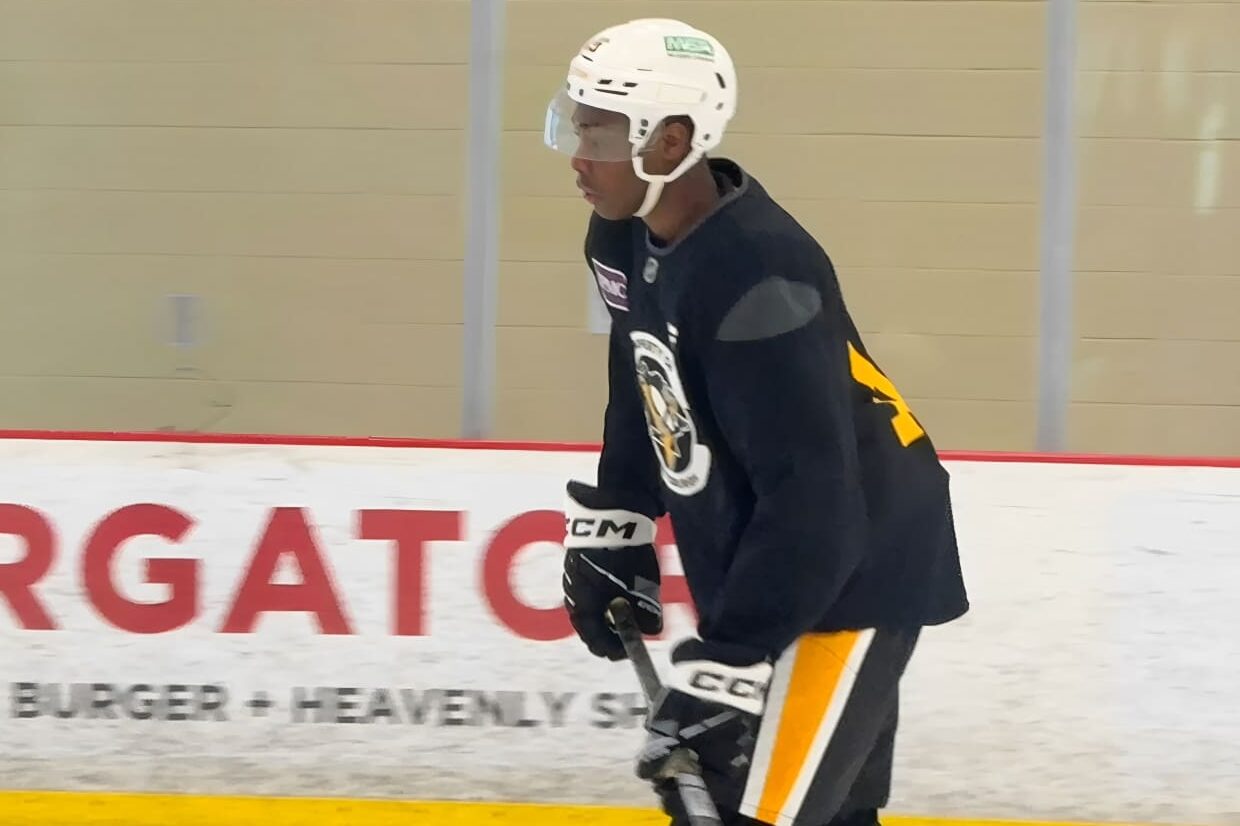Penguins
Penguins Blog: What Should Pens Do with Bill Zonnon, Better Prospects?

Gavin McKenna is the presumptive 2026 first-overall pick and will play hockey this season at Penn State before presumably enjoying fame and fortune as an NHL player beginning in the 2026-27 NHL season. This week, his decision to bolt Canadian junior hockey was more than a ripple in the pond. It signaled a seismic shift in thinking.
And player development.
Canadian junior hockey updated its transfer rules for this season and beyond, but the CHL still prohibits NHL organizations from plucking players who have not yet played four juniors seasons and stashing them in the AHL, regardless if teams think its better for the player.
The rule makes for weird situations like the Pittsburgh Penguins’ 2024 second-round picks. Harrison Brunicke was selected 44th overall but is not eligible to turn pro except to play in the NHL until next season. Tanner Howe was selected 46th overall by the Penguins, and he will turn pro this season, after he heals from a torn ACL.
So, why can Howe turn pro a year after being drafted and play in Wilkes-Barre/Scranton (or Wheeling), but Brunicke cannot?
There isn’t a really good answer except the CHL wants to protect its integrity and believes older players help develop the younger players. It’s a legitimate theory but has held back many prospects over many, many years. Penguins director of player development Tom Kostopoulos would like to see changes, especially as it relates to Brunicke.
“I think (it does present development challenges). I think it’s a good question,” said Kostopoulos following the conclusion of Penguins Development Camp. “I think it’s something that the league should look at because (Brunicke) has probably played his way out of junior hockey. He might be it might be ready for a step up.”
Kostopoulous touched on the issues regarding the limitations of junior hockey. When Auston Matthews was in a similar spot as McKenna, Matthews chose to play a year in the Swiss League to face increased competition. Such drastic measures are no longer necessary, but McKenna has kicked down the mental constructs that kept players beholden to traditional thinking and paths.
After observing him at the Penguins Development Camp, it would not be a bad idea for Bill Zonnon to follow McKenna’s lead. Zonnon is 6-foot-2 and about 190 pounds. He was clearly bigger and stronger than most of the Penguins prospects, and will be bigger and stronger than most players in the QMJHL league, too.
As fellow Penguins first-rounder Will Horcoff gets a hockey education at the University of Michigan with top notch player development staff and facilities, Zonnon is scheduled to play for the Blainville-Boisbriand Armada.
While Blainville-Boisbriand plays in a well-regarded arena, it’s a 3100 seat barn that is half the size of the facilities available to Big 10 hockey players, and those who go to the blue blood programs of the northeast, such as Boston U, Providence, and Boston College. And now, Penn State, too.
In addition to larger facilities and more personnel available, the players are bigger and stronger, too.
The latter point is why the Penguins should seriously consider directing Zonnon and other prospects to college hockey immediately.
(As a side note, if a local university is serious about a hockey program, it would be an extraordinary coup to make a deal with the Penguins to use PPG Paints Arena and recruit the Penguins’s prospects so they have quick access to the full breadth of the Penguins’ player development staff and performance department. Essentially a minor league team on scholarship. If inferred university sees this and takes the idea, you’re welcome.
And if you don’t think deals like that are coming, you haven’t paid attention to the absolute destruction of amateur collegiate athletics over the last three years.)
Last season, was Zonnon’s third in the Q, and he posted a very healthy 83 points with 28 goals in 63 games. One would expect him to dominate this season.
Third-round pick Charlie Trethewey will get a good education on the ice and the classroom at Boston University but second-rounder Peyton Kettles (39th overall), will play with the Swift Current Broncos of the WHL. Kettles has been somewhat overlooked amidst the clamor over three first-round picks and Trethewey’s local ties to the Pens Elite Program, but the 6-foot-6 shutdown defender is in the indentical situation that Brunicke found himself in, and is two years away from being able to turn pro.
Steady and stay-at-home defensemen don’t typically stand out in the 4v4 Development Camp scrimmages, and Kettles was no exception. However, he too would seem to benefit from the facilities and competition of college hockey.
Since the idea is only in its infancy, we do not expect a mass migration from the CHL to NCAA this summer or next, but even the Penguins 21 and 20-year-old Finnish prospects at Western Michigan (Iiro Hakkarainen and Joona Vaisanen, respectively) showed a different level of polish to their games and thus impressed at Development Camp.
The downside is that college players can’t realistically attend rookie camps, play in rookie tournaments, or attend training camp (in theory they could, but they cannot play against other teams, cannot miss classes, and have to pay their own way).
As more players jump to college hockey for the competition and NIL money, which is significant in some cases, the competition level will also improve, further exacerbating the developmental differences for players entering their 20s and offsetting any negatives.
Perhaps Zonnon would like a Go Blue sweatshirt or to play in the Beanpot. It might very well benefit him and the Penguins. It seems now the question is if the Penguins will be ahead of the curve and nudge their prospects to college or wait to see if it unfolds as we all think it will.



LMAO. Poor Pitt, always in awe of their big brothers in Happy Valley 🙂 We Are!
That’s not the school he was referring to.
Exactly, His references were made about a team that wears Red, White and Blue. Dan has become no fan of the CHL.
RMU
The answer to the headline is, let the prospects choose their path.
Very keen insight, sir. The idea does have merit. This is an excellent opportunity for colleges in NHL cities. Surprised this isn’t a thing, already.
That’s some pretty good advice for RM and Dusquene.
Dominating against lesser talents does not help a player’s development and can actually hinder it. Especially for bigger and stronger players, they need to compete against other bigger and stronger players. If Horcroft went to juniors instead of NCAA and can go to the net with impunity against 5′ 10″ 170lb defensemen, how would that make him a better player? His will benefit more by playing college hockey where the same moves won’t work and he’ll have to improve.
Robert Morris, Mercyhurst and Penn State are the only 3 Division 1 hockey schools in this area.
You are exactly right and that’s the problem with junior hockey in Canada and especially here in Quebec. It’s also a problem at all levels of elite hockey, even at very young ages. Too many teams, not enough good players to fill the teams so too many lesser talents! To improve and grow as a player, not only in hockey but in anything, you have to compete against the bests!! But since the only thing that counts now is $$$, over player development, it wont change anytime soon….
Penn State!🤘🤘🤘
Maybe Canada impeding the development of players is part of the reason they haven’t won the cup in forever! 😏
You mean Karma for the Canada-based NHL teams? A lot of players from Canada have won cups. They have also won World Cups, WJC, World Championships, and the 4 Nations. I think Canada is just fine. Lol
#1993forever
Who is 5’11” tall and 165 pounds, plays hockey but is not too small to succeed in the NHL?
Ben Kindle?
Nope; his lack of size has been the subject of considerable debate on PHN as to his potential to be successful at the NHL level.
Gavin McKenna?
Yep
Apparently height and weight are only limiting depending on whether other peripheral considerations are taken into account such as an ability to play hockey. Who knew?
Sidney Crosby knew.
Conclusion: maybe talent at playing hockey could plausibly seep into the discussion as to how consequential size is?
YULKC
I am from the standpoint that size only matters in hockey if you don’t go to the dirty areas and have no work ethic. There are plently examples of hockey players being below 6′ tall and still being exceptional or at least good at the NHL level.
“So, why can Howe turn pro a year after being drafted and play in Wilkes-Barre/Scranton (or Wheeling), but Brunicke cannot? There isn’t a really good answer except the CHL wants to protect its integrity and believes older players help develop the younger players.”
Actually there is a really good answer and it’s all about WHEN the player turns 20. If he turns 20 before December 31 of the given year he’s eligible for the AHL. Now why it’s that way? Completely arbitrary.